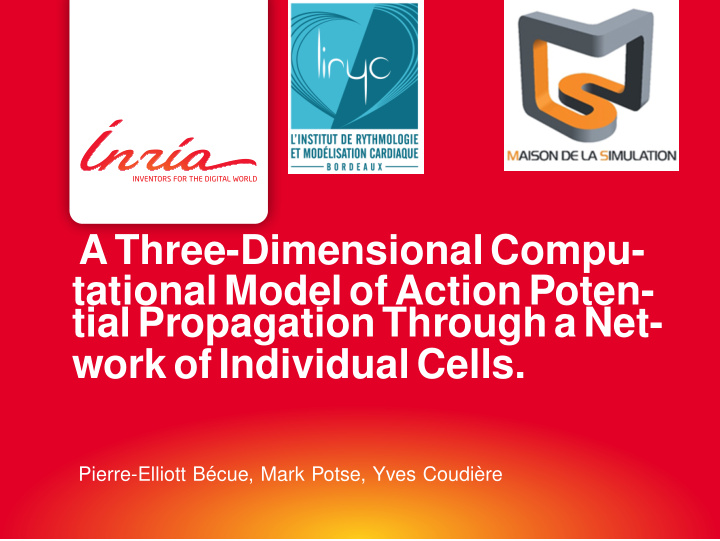



A Three-Dimensional Compu- tational Model of Action Poten- tial Propagation Through a Net- work of Individual Cells. Pierre-Elliott B´ ecue, Mark Potse, Yves Coudi` ere
State of the art and current issues • Well-known models (bidomain, monodomain) are homogenized; • Assumed periodicity; • Some specific issues (disorganization in the tissue) at the microscopic scale are arrhythmia-prone (DeBakker 1993); • Need for a “microscopic” computational model. Pierre-Elliott B´ ecue, Mark Potse, Yves Coudi` ere – 3D Model 2
Geometry of the problem and equations − σ i ∆ u i = 0 Ω i n e − σ e ∆ u e = 0 Ω e Γ e Ω − σ i ∇ u i · n i = σ e ∇ u e · n e Γ e Γ c m ∂ t ( v ) + I ion ( v ) = − σ i ∇ u i · n i Γ Ω i σ e ∇ u e · n e = 0 Γ e u i (1) • Nonlinearities on the border of n i u e the cell (ionic model) • Only v 0 provided as initial data • Pure Neumann problem Figure: Basic geometry of the problem This problem has a weak solution Pierre-Elliott B´ ecue, Mark Potse, Yves Coudi` ere – 3D Model 3
Assembly 1/2 - Variational formulation We use a P1-Lagrange finite element method with semi-implicit Euler time-stepping method u n i − u n � � � � e σ i ∇ u n + I ion ( v n − 1 ) i · ∇ ϕ i d x + c m ϕ i d s δ t Ω i Σ v n − 1 � = c m ϕ i d s δ t Σ u n i − u n � � � � e σ e ∇ u n + I ion ( v n − 1 ) e · ∇ ϕ e d x − c m ϕ e d s e δ t Ω e Σ v n − 1 � = − c m ϕ e d s δ t Σ Pierre-Elliott B´ ecue, Mark Potse, Yves Coudi` ere – 3D Model 4
Assembly 2/2 - Linear system � A n A n � � U n � = F n − 1 ion + F n − 1 i , i e , i i A n A n U n time e , e e i , e • Combination of stiffness part on the volume, mass part on the membrane and coupled terms (on A i , e and A e , i ); • Ill-conditionned problem; • We split the mesh in two parts (intra- and extracellular) and duplicate nodes on the membrane; Pierre-Elliott B´ ecue, Mark Potse, Yves Coudi` ere – 3D Model 5
Simulation protocol • Arbitrary stimulation at t = 0 . 1 ms for 0 . 02 ms between an anode and a cathode; • Use of Mitchell-Schaeffer model; • 2D cases: cells are 100 × 20µm 2 , 3D case: three cells embedded in a domain of size 300 × 100 × 70µm 3 ; • Extra/intracellular conductivity ratio is 1 . 75. Pierre-Elliott B´ ecue, Mark Potse, Yves Coudi` ere – 3D Model 6
2D simulation - Single Cell (a) Potential field at t = 0 . 15ms (b) Potential field at t = 0 . 40ms (c) Potential field at t = 5 . 0ms Figure: First test case with a single cell, with an initial stimulation of intensity I = 4 . 6. Pierre-Elliott B´ ecue, Mark Potse, Yves Coudi` ere – 3D Model 7
2D simulation - Two connected cells (a) Potential field at t = 0 . 15ms (b) Potential field at t = 5 . 0ms Figure: Second test case with two connected cells, with an initial stimulation of intensity I = 11 . 0. The channel dimensions are 10 × 2µm 2 . Pierre-Elliott B´ ecue, Mark Potse, Yves Coudi` ere – 3D Model 8
3D simulation (a) Surface of the cells for the 3D case. (b) Potential field at t = 0 . 4ms • 1.2M elements; • 214k nodes; • 40 000 steps; • 4 3.3 GHz CPUs; • 53.2h (whole AP). (c) Depolarization process on the 4 colored points. Pierre-Elliott B´ ecue, Mark Potse, Yves Coudi` ere – 3D Model 9
Conclusion and further work • A numerical solver of the microscopic bidomain model; • It works in 2D and 3D; • CPU time is reasonable. • Build larger network of cells (in 2D) to test the propagation of the action potential; • Implement a more accurate gap-junction model (Davidovic, CinC 2015); • Test the scaling on clusters. Pierre-Elliott B´ ecue, Mark Potse, Yves Coudi` ere – 3D Model 10
Recommend
More recommend